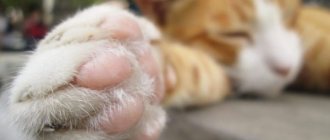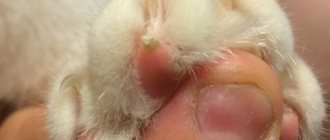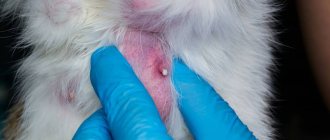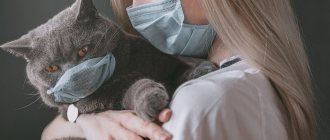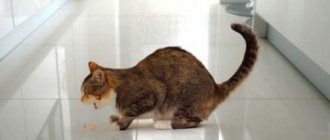Coughing is a protective reaction of the cat’s body from foreign objects that enter the respiratory tract, esophagus or stomach. Coughing can also be caused by hairballs in the stomach, inflammatory processes in the respiratory system, attacks of allergies or bronchial asthma.
If the owner notices that the cat is choking and coughing, as if it has choked, immediate measures must be taken to save the animal from suffocation. Let's find out why a cough occurs and how to independently help your pet before the veterinarian arrives.
Mechanism of cough development
A periodically occurring cough in a cat may indicate the development of inflammatory processes in the respiratory system, which require long-term treatment under the supervision of a veterinarian. It can also occur when trying to get rid of hairballs that accumulate in the animal’s stomach.
However, if the cat spontaneously begins to cough, wheeze, stretch out and press itself to the floor, this most often indicates ingestion or inhalation of small foreign objects. In this case, the animal must be quickly assisted or taken to the clinic without delay.
A cough is a strong, accelerated exhalation through the mouth, which occurs due to a sharp contraction of the muscles of the respiratory tract as a result of irritation of the receptors. In this way, the cat's respiratory tract is freed from mechanical substances that impede the movement of air along the airways.
The cough algorithm consists of the following stages:
- take a deep breath for no more than 2 seconds;
- reflex contraction of the smooth muscles of the larynx, which closes the glottis;
- increased tone of the bronchial muscles;
- sharp contraction of the abdominal muscles;
- opening of the glottis;
- a powerful exhalation that expels foreign agents.
Normal breathing
If a healthy cat wheezes when breathing, its chest rises and falls rhythmically. All this happens without sudden movements.
Experts note 2 points that can make a cat’s breathing quicken for a while:
- stress due to emotional overexcitation;
- the presence of a large amount of hair in the respiratory tract.
Important! There is no need to worry about such wheezing, since calm breathing is restored after a short period of time.
Sometimes a kitten wheezes during a deep sleep. In this state of complete relaxation, the baby’s pulse quickens, but this does not affect his health.
A cat's normal breathing is almost silent. True, in her sleep she can quietly sniffle and snort. But if there are no convulsive sighs with whistling, wheezing sounds, this condition is considered normal.
Types and symptoms of cough in cats
The classification of cough in cats is described in detail in the table.
| Characteristics of cough | Degrees and types of cough manifestations |
| Force | slight cough; hacking cough |
| Form depending on duration | acute (less than 14 days); prolonged (from 14 to 45 days); chronic |
| Timbre | silent; voiced; deaf; hoarse; hoarse; barking |
| Presence of discharge | dry; wet |
| Character of sputum | serous; slimy; purulent; mixed with blood |
| Development time | constant; seasonal |
Symptoms that most often accompany coughing in cats include:
- discharge from the nasal cavity;
- vomit;
- wheezing.
The nature of the cough helps specialists make the correct diagnosis, identify the causes and prescribe appropriate treatment for a coughing cat.
Take care of the sick
What to do if your cat has a stuffy nose? First of all, you must improve the living conditions of your pet. Give large quantities of warm water only, and it is also better to feed warm food during the period of illness. Watch carefully for drafts. If your cat has a cold, you can put a heating pad in her house.
Remove discharge from the nose and crust with a damp cotton swab or disk. If the cat does not have a fever, warm its nose with a bag of hot sand or coarse salt. Brew chamomile and wipe your watery eyes with this infusion. Chamomile will relieve inflammation.
If your cat is sneezing and has a stuffy nose, try rinsing her nasal passages. Add two teaspoons of sea salt to a glass of boiled water. If possible, you can dilute beet juice with water in a ratio of one to three. You can instill it into your nose with a pipette or syringe without a needle. Before the procedure, try the prepared solution on yourself, because cats have more delicate mucous membranes than people.
Buy food with a stronger smell. If a cat has a stuffy nose, she doesn't smell well. When she smells such food, she will happily eat.
In winter, when the heating is on, it is better to cover the radiators with wet towels: dry air is more difficult to breathe.
Misconception
If your cat does not leave the apartment and does not come into contact with other animals, this does not mean that she cannot catch an infection or virus. You yourself can carry germs and parasites on your clothes or shoes.
Main causes of cough in cats
Veterinary experts identify 6 main causes of cough in cats.
- Bronchial asthma. This is one of the types of allergies that occur in a cat to foreign components that can be contained in dust, pollen, hair from other pets, dead particles of human skin, as well as in medications and chemicals.
- The presence of foreign objects in the upper respiratory tract, esophagus or stomach.
- Pathologies of the cardiovascular system.
- Helminthic infestations. During migration, Toxocara larvae enter the lungs. This most often occurs in young animals due to untimely deworming after weaning. In this case, the kitten coughs heavily and may vomit a foamy mass in which parasites are found. The cat may also cough constantly due to the presence of heartworms in the pulmonary arteries. These thin, long helminths parasitize the heart, pulmonary artery and small capillaries. They clog blood vessels, which causes frequent severe coughing, vomiting, shortness of breath, loss of appetite, and in case of severe infestation, convulsions and death.
- Infectious diseases of the upper respiratory tract. The most common diseases include herpes, rhinotracheitis and calicivirus.
- Pneumonia. The etiological factors for the occurrence of pneumonia in cats are pathogenic bacteria, viruses, microscopic fungi, as well as external factors such as hypothermia, eating cold food, and keeping the animal in unsanitary conditions.
- Malignant tumors in the respiratory organs.
Important! Among infectious agents, a special place is occupied by the pathogenic bacterium Bordetella bronchiseptica, which causes bordetellosis. Most often, this disease is transmitted by airborne droplets when cats are kept in crowded conditions in nurseries. The infection is also spread by stray cats, which can infect free-roaming pets.
If the cat is coughing heavily and breathing heavily, then the cause of this condition may be pneumo- or hydrothorax, caused by the penetration of air or liquid into the chest cavity.
Helminths
Worms that appear in the body irritate the mucous membrane, causing a cough. This is often accompanied by weight loss, vomiting and dandruff. To combat them, the pet is given antihelminthic medications. In severe cases, they are given again a week after the first dose. Delay can lead to problems with the liver, kidneys and even death.
Trichobezoars, coughing up hair
Cats groom themselves by licking their fur coat with their tongue. That, in turn, can enter the digestive organs. The lumps formed there provoke coughing. It doesn't pose a threat. A paste that dissolves lumps or special food will help.
To measure the temperature
Throat injuries
They also irritate the larynx. Sores and ulcers can be a sign of chlamydia, which people can become infected with.
Heart diseases
Cardiac cough gradually intensifies and is accompanied by lethargy, shortness of breath, and heavy breathing. A cardiogram will confirm this version.
Respiratory diseases
These include viral, bacterial, and fungal infections. Immediately the cough is dry and loud. On the second day, sputum separates and he becomes deaf. In addition, nasal discharge, rotting of the eyes, weakness, and increased body temperature appear.
Read also: How to make an apartment communal
Pneumonia
Pneumonia can develop as a result of hypothermia, characterized by a dry barking cough, wheezing, increased body temperature, weakness, and refusal to eat. It often occurs against the background of other infections. Antibiotics and mucolytic expectorants are used for treatment.
Survey
Diagnosis of the condition
The multiplicity of causes that can cause cat cough makes it very difficult to diagnose cats. Therefore, the veterinary specialist consistently conducts a series of studies, including:
- collection of anamnestic data;
- inspection;
- palpation;
- percussion;
- auscultation;
- general and clinical blood test;
- radiography;
- coprogram for identifying intestinal helminth eggs.
If it is not immediately possible to determine the reason why the cat cannot cough, the veterinarian will prescribe additional laboratory and instrumental tests.
Note! Only large veterinary clinics can afford additional research, and the cost of these services is quite high. Therefore, it is advisable to carry them out more often for such high-pedigreed “expensive” cats as Sphynx, Maine Coon, Peterbald, Scottish Fold and others.
Specific additional studies that will help determine exactly why a cat is coughing with wheezing include:
- sputum analysis for the presence of viral agents and their identification;
- fluoroscopy of the esophagus using a contrast indicator;
- endoscopy of the upper respiratory tract and esophagus;
- bronchoalveolar lavage (performed under general anesthesia).
If the doctor suspects that the cat cannot cough due to the development of pathology of the cardiovascular system, the doctor will prescribe an ECG or ultrasound of the heart.
Pulmonary causes of wheezing
Pulmonary causes can be associated with inflammatory processes in the bronchi and lungs of an allergic and non-allergic nature, and with respiratory tract injuries (foreign body entry, hematomas, pneumohydrothorax, diaphragmatic hernia).
Cats do not get the flu or ARVI. But they have their own viral infections (rhinotracheitis, calcivirosis), which can cause the animal to cough and wheeze.
Rhinotracheitis and calcivirosis
Both diseases are viral in nature and are quite dangerous for cats. Both are accompanied by damage to the mucous membranes of the respiratory tract and intestines. They occur with high fever, diarrhea (in severe cases with dehydration), cough and wheezing. With calcivirosis, the cat's visible mucous membranes and tongue are ulcerated. With rhinotracheitis, there is abundant mucopurulent discharge from the eyes and nose.
Pneumonia
This disease in cats can be bacterial, viral or fungal in nature. At first, a strong “barking” cough appears, as if scratching the airways, and the temperature rises. Then the cough becomes wet with wheezing of large or fine bubbles. The general condition of the animal is impaired.
Bronchial asthma
An animal with this pathology takes a characteristic position: presses against the floor, stretches its neck, makes wheezing sounds, and sometimes coughs. In severe cases, expiratory shortness of breath up to suffocation is observed. With asthma, owners often believe that their animal is choking, which is why it wheezes.
Helminthiasis
Wheezing, similar to symptoms of bronchial asthma, can be caused by the migration of parasites. The most common diseases found in cats are aleurostrongylosis (more common in America) and dirofilariasis.
Oncology
Tumors of the respiratory tract can be benign and malignant, primary and metastatic. Oncopathology of the respiratory system is less common in cats than in dogs. Older animals get sick more often. The development of a tumor in any part of the respiratory tract can cause breathing problems and wheezing. The most common signs of growth of a tumor in the larynx are impaired breathing, difficulty, hoarseness and changes in voice. The pet's voice becomes squeaky or hoarse. The disease is accompanied by shortness of breath and cough, sometimes mixed with blood.
Brachycephalic syndrome
The disease involves pathological growth of the tissues of the velum and narrowing of the nasal passages. The animal wheezes and wheezes heavily. He sleeps with his mouth open and snores. He eats normally. Remains active.
Laryngeal edema, laryngospasm
This condition can develop as a result of poisoning with household chemicals, allergies to inhaled dust, tobacco smoke, strong aromas, etc., an autoimmune reaction. Much less often, mechanical damage to a cat’s larynx leads to laryngospasm. At the same time, the animal’s body feels an acute lack of oxygen and stress hormones are released. The cat is frightened, wheezes and wheezes heavily, breathes with difficulty, whistling, and screams in a “bad” voice.
Pneumo- and hydrothorax
Develops as a result of rupture of the lungs by a tumor, open wound or closed injury. The pet's breathing is difficult, he sits with his mouth wide open, breathes with difficulty and hoarsely, and is very scared.
Inhalation of a foreign object
A foreign body can get stuck in the animal’s pharynx, trachea and bronchi. It may be small and move along the bronchial tree, causing bouts of repeated coughing and wheezing. Or large and block the airways partially (working as a valve) or completely. In this case, the animal coughs, wheezes heavily, rubs its neck on objects, and mucous-foamy sputum, sometimes mixed with blood, is released from the nose. The animal does not drink, does not eat and may suffocate.
Pulmonary edema
Pulmonary edema can be caused by a variety of diseases of internal organs, injuries and inflammation of the lungs, aspiration of vomit, water, and small objects. The cat takes a forced position, breathes hoarsely, with difficulty, pink foam comes out of its nose, and its sides swell.
Congenital pathologies
Narrowing of the nasal passages, an elongated soft palate, and polyps can cause breathing problems and hoarse sounds heard when the animal breathes, especially after exercise.
Tracheal collapse
At the initial stage, it does not cause any particular concern to the animal. Manifests itself in the form of a cough during a strong emotional outburst. Over time, the condition worsens, hoarse breathing appears, shortness of breath, and the cough intensifies. The animal may lose consciousness.
How to treat cat cough
If a cat is coughing, it can be treated at home only after being examined at a veterinary clinic, making an accurate diagnosis and prescribing appropriate therapy.
You should not self-administer cough suppressants before visiting a doctor, as this may change the clinical picture of the disease and make it difficult to determine the cause of the pathology.
Important! If the cat is coughing and wheezing, as if he is choking, then you should not take any independent action. It is better to quickly take your pet to the hospital or call a doctor at home. Delay can also be fatal when the cat wheezes, trying to burp, but only spits up saliva or foamy liquid.
If a cat coughs due to an infectious disease of viral etiology, the doctor prescribes:
- antibacterial drugs (Amoxisan, Sinulox, Tsiprovet) to prevent the development of secondary bacterial infections;
- mucolytic and expectorants (Bromhexine, licorice extract);
- immunomodulators (Cycloferon, Fosprenil, Maxidin);
- globulin Vitafel;
- intravenous injections of Ringer-Locke solution or saline with 5% glucose (to prevent dehydration when refusing food).
If the cough is accompanied by wheezing and the cat coughs while stretching its neck, then the cause may be pneumonia or another inflammatory process in the respiratory system. In this case, antibiotics are first prescribed. And to relieve coughing, the cat should be given antispasmodics, mucolytics and expectorants.
If a cat's cough is accompanied by vomiting, this often indicates helminthiasis. In this case, anthelmintic drugs are prescribed (Pyrantel, Prazicide, Drontal, Milbemax). Despite the fact that these medications are sold in pharmacies without a prescription, you should not use them yourself if your cat wheezes and tries to burp.
In case of severe infestation, an incorrectly selected dosage can lead to excessive activity of parasites and lead to suffocation. Illiterate actions by owners can also lead to intestinal rupture or excessive intoxication in small kittens.
If the reason that the cat is coughing and stretching its neck, as if choking, is trichobezoars, then the doctor will prescribe special pastes and gels to remove or dissolve hairballs in the stomach.
If a cat coughs and wheezes with its tongue hanging out, this may indicate an attack of bronchial asthma. You can quickly relieve an attack with:
- glucocorticosteroids (Hydrocortisone, Prednisolone, Dexamethasone, Fluocinolone);
- bronchodilators (Theophylline, Atropine);
- antibiotics (if there is a threat of infection by pathogenic bacteria).
Important! Self-administration of glucocorticosteroid and bronchodilator drugs to treat Sphynxes and other cats when they cough while stretching their necks can lead to overdose, complications and the development of side effects. Therefore, you should not put your pet’s life at risk; you must urgently take him to the clinic.
The reason that the cat is coughing, wheezing, as if he is choking, may be a heart attack, which develops in the cat as a result of a hidden pathology of the cardiovascular system. In this case, any independent treatment is unacceptable.
You should immediately call the clinic, call a veterinary specialist to your home and get a recommendation on the actions that need to be taken before his arrival.
What is a cough
A cough in a cat, like in a person, is a protective reaction of the body when a sharp expulsion of air occurs through the mouth - a loud exhalation. This is necessary to remove foreign objects from the respiratory tract: particles of substances, dust, as well as bacteria, viruses, fungi, mucus that accumulates during inflammation.
In cats, cough receptors are located in the trachea, larynx, and bronchi. Therefore, cough in animals occurs due to pathologies in these organs. However, these same cough receptors also respond to external irritation from neighboring organs and tissues. Hence, the number of reasons that can cause coughing and wheezing in a cat increases sharply.
Sometimes the cough is accompanied by vomiting. The acidic contents of the stomach enter the larynx, irritate it and the coughing attack intensifies. Therefore, the owner, seeing a coughing pet, thinks that he is vomiting.
It is important for the owner to be able to distinguish between states when the animal wants to vomit or regurgitate, and when it coughs.
To do this, you need to understand how cats cough:
- The back arches, and the abdominal wall is pressed inward, pulling toward the spine.
- The cat, pressed to the floor, lowers its head and stretches its neck forward.
- The mouth opens slightly and a characteristic coughing sound is heard.
How to understand that a cat is not just coughing, but choking
If a cat coughs, wheezes and at the same time stretches out, pressing her whole body to the floor, then in 99% of cases this indicates that a foreign object has entered the esophagus or respiratory tract. When a cat coughs as if he is choking, you should not do anything on your own. You should immediately take your pet to the clinic.
Sometimes the cat gags and coughs, as if he wants to vomit, but attempts remain to no avail. This may indicate that the pet is unable to get rid of a large trichobezoar in the stomach on its own.
If the cat coughed, as if she was choking, but quickly came to her senses, then there is no reason to worry, as she could simply have choked.
Treatment of cough at home
At home, the owner can help his pet only in two cases:
- it is possible to remove the foreign body;
- the cat inhaled gases or smoke.
In the latter case, the most important thing is to eliminate the effect of irritants and ensure a flow of fresh air. To do this, either take the pet outside or place it in a well-ventilated area.
If there are other accompanying symptoms, you cannot treat them at home or give your cat medications. Firstly, it can make the situation worse. Secondly, it will blur the overall picture and complicate the doctor’s task of making a diagnosis.
How to help a cat who is choking
If, after eating fish or tubular bones, the cat sticks out its tongue, coughs, wheezes, or simply sits with its mouth slightly open, then there is a high probability that a sharp bone is stuck in its throat or esophagus.
If you have experience with animals, you can try to remove it yourself. But this can only be done if the bone is clearly visible in the oral cavity. To do this, you need to secure the cat. Then ask an assistant to hold the animal and try to open the pet's mouth wide.
The next step is to remove the bone using tweezers.
If the cat coughs, wheezes, or sticks out its tongue and makes wheezing sounds, but upon examination a foreign object cannot be detected, then the animal should be taken to the doctor immediately.
Why does a cat cough and wheeze, what diseases can there be?
A cat’s cough , as a rule, never occurs as an independent disease. Most often it is a symptom of other diseases.
These are not all the reasons why a cough may occur. More than 100 diseases are currently
which are accompanied by this reflex.
Therefore, if your cat is coughing , then this is an excellent reason to grab your pet and rush to the veterinarian, who will examine the furry cat and make the correct diagnosis.
Preventive measures
To minimize the risk of a hoarse cough in cats, you need to adhere to the following rules:
- promptly vaccinate the animal against infectious diseases;
- carry out regular treatments against helminths and skin parasites;
- brush the hair of representatives of long-haired breeds daily;
- periodically feed gels and pastes to remove hair from the stomach;
- prevent pets from hypothermia;
- strictly observe the rules of cat hygiene and ensure high-quality living conditions;
- Do not feed your cat raw river fish and tubular bones.
If, however, a situation arises in which the cat begins to cough, wheeze and cling to the floor, then you should immediately go to the veterinary clinic. Specialists will quickly find out the causes of these symptoms and provide qualified assistance.




